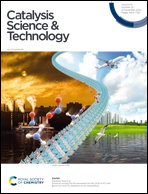Selective oxidation of crotyl alcohol by AuxPd bimetallic pseudo-single-atom catalysts†
Abstract
AuPd bimetallic single-atom catalysts are being extensively studied as selective catalysts for hydrogenation and oxidation reactions due to their high selectivity. Previous work in our group has shown that alloy and core–shell AuPd nanoparticle catalysts can selectively oxidize crotyl alcohol to crotonaldehyde at room temperature in base-free conditions. In this work, we discuss the synthesis, extensive characterization, and activity for crotyl alcohol oxidation across a series of AuxPd catalysts (x = 4, 3, 2, and 1) made by both co-reduction and sequential reduction strategies, in order to examine whether single-atom systems can lead to improved activity and/or selectivity for this reaction. X-ray absorption spectroscopy data shows that both co- and sequentially-reduced Au4Pd catalysts have very small Pd–Pd coordination numbers, with values of 1.2 ± 0.3 and 1.6 ± 0.3, respectively, which indicates that they are closest to single-atom systems. The co-Au4Pd catalyst, with the lowest Pd–Pd CN, also exhibits the highest selectivity for the selective oxidation of crotyl alcohol to crotonaldehyde. We were further able to enhance the selectivity of the AuPd nanoparticle catalysts by incorporating vinyl acetate as a hydride scavenger. We show in this paper that dispersing Pd in a Au matrix can lead to very selective catalysts while also lowering the amount of Pd needed in the system.



 Please wait while we load your content...
Please wait while we load your content...